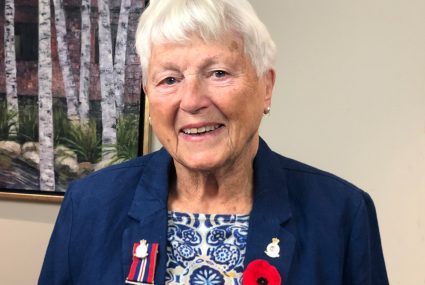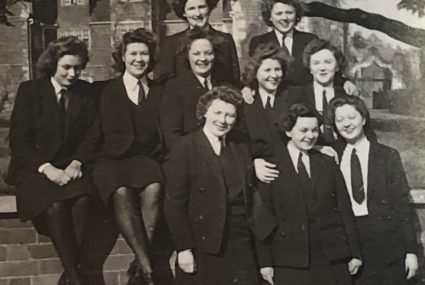In the summer of 1944, 18-year-old Margaret ‘Peg’ Jones entered the lodge house inside the big gates of Bletchley Park. As she signed her name on the Official Secrets Act, she had no idea what awaited her in the hub of Britain’s World War II codebreakers. Standing with her fellow Women’s Royal Navy Service recruits (WRNS or ‘Wrens’), the gravity of the situation dawned. An officer gave a chilling warning: if they talked about Bletchley Park—they would be shot.
How To Become A Codebreaker
Born in 1926, in Liverpool, Peg was 13 years old when World War II began. She was just 16 the first time she attempted to sign-up to serve. However, the doctor in charge of her physical exam called her bluff and told her to come back when she was 18. Peg was undaunted; at 17.5 years old, she began to volunteer with the Wrens, counting down the ‘longest six months of my life’ until she was officially old enough to serve.
Serving with the Wrens
Reporting for service, she joined the other Wrens in learning to march, salute, and spend the night on benches during buzz bomb air raids. As training ended, Peg went to placement interviews. Expecting a future as a cook, steward, or ships’ crew, some of the interview questions surprised her.
Do you like crosswords? “Yes, my brother Ken and I used to make them up for each other. We loved making them.” Do you ride a bicycle? “Yes.” Do you like living in the country? “We’re Navy; I thought we would be going to the coast.” This was the first hint that her life was taking an unexpected turn.
Shrouded in Mystery
She reported to Eastcote on the outskirts of London. There Peg came face to face with the bombe. The bombe was a code-breaking device developed by Alan Turing and used by British cryptologists to decipher secret messages sent from Axis-controlled Enigma machines. “It was like a big cupboard; a sea of wires and disks turning on the front with letters on them,” Peg recalls, “It made a dreadful racket!”
With other Wrens, she learned the art of operating the bombe. “We were given a piece of paper with letters on it and were taught to put those letters onto disks that also had letters on them. It would run, we would wait until it stopped, and then write down where the letters were on a piece of paper and hand it to the IT ops. She would take it away.”
Everything was shrouded in mystery. “We were instructed to tell no one what we were doing. They said we would hear the word Enigma and we were to close our ears and never use it ourselves. We had no idea what the name meant; we didn’t even know what the word meant.”
Fast Friends at Bletchley Park
Allied troops landed on Normandy Beach on June 6, 1944. In July, Peg arrived at Bletchley Park— the British Government’s Communication Headquarters and joined A Watch. The young women of A Watch worked in sparsely furnished Hut 11A operating the bombes eight hours a day. It was the beginning of one of the biggest adventures of her life.
The girls that Peg worked with became as close as sisters. They quickly developed their own code, giving each other chummy nicknames: Clipper, Squeeg, Nuts, Phil, Ishy, and others. To her dismay, they labelled her ‘Peggie.’
“We lived together, worked together, ate together and slept together in the same room. What a great bunch of girls they were!” In their spare time, the young ladies rode their bikes or hitchhiked around the countryside, attended RAF and US Airbase dances, and tried to stay out of trouble.
Secrecy was an essential part of life at Bletchley. In 1942 a security warning to all staff stated, “Do not talk at meals. Do not talk in the transport. Do not talk travelling. Do not talk in the billet. Do not talk by your own fireside. Be careful even in your hut.”
The young women led active social lives, and the confidentiality of their work necessitated a good cover story. Peg notes they were required to make something up, and they employed their imaginations to do so.
“We’d be on a train or at a pub, and someone would ask, ‘What are the Wrens doing here in the country?'” Peg wove a yarn about serving on an aircraft carrier. Her job was to ride her bike across the deck to deliver last-minute orders to pilots before take-off. “We told them we were in the country on respite because our jobs were stressful. People believed us! No one ever said, ‘You’re kidding.’ It was crazy!”
Working on Secrets
The friendships were extraordinary, but the work of code-breaking wasn’t glamorous. “It didn’t really make sense to us,” says Peg. “Although we knew they were coming from Germany and were for German troops, we never knew what those letters we passed on meant. Other sections translated, and we never knew what the people working around us were doing.”
The girls did celebrate cryptic victories along the way. “Sometimes the phone would ring, and the voice on the other end would say ‘You got a job up,’ which meant that we’d broken the code,” Peg remembers. “We all got very excited!”
Peg also worked as a switchboard operator in a smaller room within the hut. Her board had a direct but scrambled line to Sir Winston Churchill’s office, and she could tell when a call went through. It also gave her direct access to the giant spiders that came through the roof of the switchboard room. She would often call the skills of the RAF technicians to rescue her from the arachnids.
Life in the Bletchtly Park Zoo
The atmosphere around Bletchley Park itself was fascinating. “It was a weird place, rather like a zoo,” says Peg, “There were some very strange people—all those mathematicians were a bit squiggly. They would walk around in their pyjamas having been there all night long, or they would talk to themselves as they walked. We didn’t talk to anyone. If you bumped into someone you didn’t even say ‘I’m sorry.'”
Every day the Army, Navy and specialized civilians came to work run three shifts at Bletchley. Along with them came a variety of important guests. As switchboard operator, Peg found herself escorting these guests to see the bombes. Among them were General Eisenhower and Former Prime Minister Anthony Eden. “There were always very important people around,” she remembers, “I treated them all with the same awe.”
After the War
And then the war was over. Sir Winston Churchhill proudly commended Bletchley Park as the secret weapon that won the war, calling it the “geese that laid the golden eggs but never cackled.” In October 1945, the ladies of A Watch tore the bombes apart, leaving nothing larger than two-inch long wires and piles of nuts and bolts.
A Watch went their separate ways. They left with promises of meeting on the steps of St. Paul’s Cathedral in ten years.
Whether or not they ever did, Peg doesn’t know. She spent the next four years serving as a Wren at different Royal Navy Air Stations throughout England. In 1949, while working at RNAS Saint Merryn, Cornwall, she met Buck Buchanan, a handsome Brit with the Royal Canadian Navy who was there for training. They married, and two weeks later, Peg Buchanan was on a plane bound for her new life in Ottawa, Canada. She stored the secrets of her time at Bletchley Park deep in a vault in her mind protected by sheer force of will.
“I never said a word to anyone, not even my husband or family members,” says Peg. “When I heard the word Enigma I went cold.” Thirty years later, in 1974, she and others who had worked at Bletchley received official permission to talk. She could finally tell Buck and her six children about her work as a code breaker. Buck was unphased. Upon hearing her news he said, “I thought it might be something like that.”
Bletchley Park Secrets Revealed
In 2014, Peg was in Florida visiting her daughter when the work done at Bletchley Park hit a new level of exposure. “Heather said, ‘There’s a movie that we should see.’ We went to see The Imitation Game, and I was really surprised! Benedict Cumberbatch had that vague look about him—looked just like what you would see at Bletchley—distracted and thinking!” As the movie ended, the crowds around them started to leave. Heather proudly turned to Peg and said, “I just wanted to stand and shout out, “My Mom was there!”
Over the years, the fascinating truth about the work Peg was involved in has become more accessible to the public. As information comes to light, even Peg is amazed! “In those days, we didn’t know what was going on. We had no idea the series of things that went on and what the results were. When it all came out, I said, “Huh. So that’s what we were doing there!”
When Buck retired from service, he and Peg and their six children moved to Ladner, BC and fell in love with the west coast of Canada. Buck died in 2004 and in recent years Peg, has enjoyed the social family-atmosphere of life at The Wexford, a seniors’ living community in Tsawwassen.
Back to Bletchley
In 2018, Hut 11A became a public exhibit called ‘The Bombe Breakthrough.’ A tour through the space gives guests a peak at original blueprints for the bombe, components of decrypted Nazi messages, the Wrens visitor book, and a framed photo of Peg and the ladies of A Watch.
Along with an enthusiastic troop of extended family members, Peg returned to Bletchley Park this fall. In the centre of the grounds stands a new brick wall—The Codebreakers Wall—a memorial to the veterans who served at Bletchley. Peg ran her fingers across the names printed on the bricks until she proudly arrived at her own. It’s a brick that represents the role she played in an operation that changed the world.
“It was just something I did,” muses Peg cavalierly when asked about the significance of the work. “We were just doing our job. What an adventure that was!”


Comments